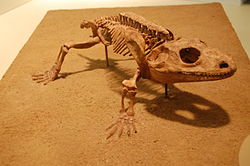- Dissorophidae
-
Dissorophidae
Temporal range: Late Carboniferous - Middle Permian, 304–268 Ma
Skeleton of Cacops in the Field Museum Scientific classification 
Kingdom: Animalia Phylum: Chordata Class: Amphibia Order: †Temnospondyli clade: †Olsoniformes Family: †Dissorophidae
Boulenger, 1902Subfamilies and genera Dissorophidae is an extinct family of medium-sized, temnospondyl amphibians that flourished during the Late Pennsylvanian and early Permian periods in what is now North America and Europe. Despite being amphibians, they seem to be well developed for life on land, with well-developed limbs, solid vertebrae, and a row of armour plates of dermal bone, which both protected the animal and further strengthened the backbone.
A well known genus is Cacops, a squat solid animal from the late Early Permian (Artinskian age) Clear Fork group of Texas, with a relatively huge head, and a row of armor plates along the back. In the similar but slightly larger and more specialised genus, Platyhystrix, whose fossil remains are known from the Cutler Group of Utah, Coloardo, and New Mexico, the armor developed into a sort of ridge or sail.
Not all Dissorophids were squat-bodied big headed animals. Fayella, from the late Artinskian of Oklahoma, was lightly built with long limbs, obviously relying on speed rather than armour plating as a defense against predators.
There are a number of related forms which seem to have been more aquatic, which are known from the Late Permian of Russia and the Early Triassic of Gondwana.
It has been suggested that the Dissorophidae may be close to the ancestry of modern amphibians (Lissamphibia), as it is closely related to another family called Amphibamidae that is often considered ancestral to this group.
Fossil range
Below is a timeline of the known fossil ranges of dissorophids.[1]

Phylogeny
Below is a cladogram from Reisz et al. (2009):[2]
Dissorophoidea Olsoniformes Trematopidae
Dissorophidae Ecolsonia
Dissorophinae Broiliellus
Cacopinae References
- ^ May, W.; Huttenlocker, A.K.; Pardoc, J.D.; Bencab, J.; and Small, B.J. (2011). "New Upper Pennsylvanian armored dissorophid records (Temnospondyli, Dissorophoidea) from the U.S. midcontinent and the stratigraphic distributions of dissorophids". Journal of Vertebrate Paleontology 31 (4): 907–912. doi:10.1080/02724634.2011.582532.
- ^ Reisz, R.R.; Schoch, R.R.; and Anderson, J.S. (2009). "The armoured dissorophid Cacops from the Early Permian of Oklahoma and the exploitation of the terrestrial realm by amphibians". Naturwissenschaften 96 (7): 789–796. doi:10.1007/s00114-009-0533-x.
- Anderson, J. M. & Cruikshank A. R. I. (1978), The Biostratigraphy of the Permian and Triassic, Part 5, a review of the classification and distribution of Permo-Triassic Tetrapods. Paleontol. Afr. 21: 15-44.
- Benton, M. J. (1993) The Fossil Record 2. Chapman & Hall, London, 845 pp.
- Carroll, R. L. (1988), Vertebrate Paleontology and Evolution, WH Freeman & Co.
- Reisz, Robert, (no date), Biology 356 - Major Features of Vertebrate Evolution - The Origin of Tetrapods and Temnospondyls
Major clades Related articlesRelated categoriesTemnospondyls · Carboniferous amphibians · Permian amphibians · Triassic amphibiansDissorophoidea Amphibamus · Doleserpeton · Eoscopus · Georgenthalia · Gerobatrachus · Limnerpeton · Micropholis · Pasawioops · Platyrhinops · Plemmyradytes · Rubeostratilia · TersomiusBranchiosauridaeApateon · BranchiosaurusBranchierpeton · Limnogyrinus · MicromelerpetonDissorophidaeAlegeinosaurus · Anakamacops · Arkanserpeton · Aspidosaurus · Astreptorhachis · Brevidorsum · Broiliellus · Cacops · Conjunctio · Dissorophus · ?Ecolsonia · Fayella · Iratusaurus · Kamacops · Longiscitula · Mordex · Platyhystrix · ZygosaurusTrematopidaeAcheloma · Actiobates · Anconastes · ?Ecolsonia · Fedexia · Phonerpeton · TambachiaEryopoidea ParioxyidaeParioxysCategories:- Temnospondyls
Wikimedia Foundation. 2010.
